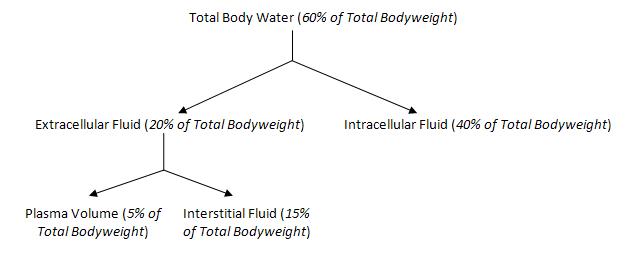Principles of Fluid Therapy
Revision as of 21:55, 11 April 2009 by Hstenning (talk | contribs) (New page: {{unfinished}} ==What is Fluid Therapy?== '''Fluid Therapy''' is the administration of fluids to a patient as a treatment or preventative measure. It can be administered via an intravenous...)
| This article is still under construction. |
What is Fluid Therapy?
Fluid Therapy is the administration of fluids to a patient as a treatment or preventative measure. It can be administered via an intravenous, intraperitoneal and subcutaneous routes. 60% of total bodyweight is accounted for by the total body water. This can further be divided into intracellular or extracellular as shown below.
Indications
Selection of fluid type administered depends upon indications for why fluids are required. Some of these includes: -
- Hypotension
- Hypovolemia
- Electrolyte, metabolic and acid base disorders
- Decreased oxygen delivery
- Geriatric patients at risk of organ failure
Definitions
- Osmosis is the net movement of water across a semi permeable membrane. The movement is caused by a concentration gradient due to different solute concentrations.
- Osmotic Pressure is the pressure caused by the solutes within the solution. The solute concentration prevents water movement across the membrane.
- Tonicity is the term used to compare the osmotic pressure of different solutions
- A hypotonic solution is one that has an osmotic pressure lower than plasma.
- A isotonic solution is one that has an osmotic pressure the same than plasma.
- A hypertonic solution is one that has an osmotic pressure higher than plasma.
Types of Fluids
- Crystalloids
- Colloids
- Blood Products
